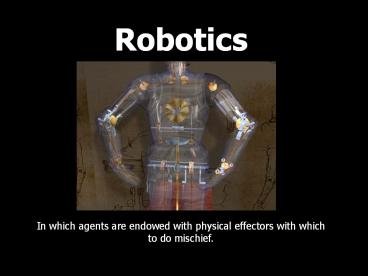Robotics - PowerPoint PPT Presentation
Title: Robotics
1
- Robotics
In which agents are endowed with physical
effectors with which to do mischief.
2
Introduction
- Robot Institute of America defines robot as a
reprogrammable, multifunction manipulator
designed to move material, parts, tools or
specific devices through variable programmed
motions for the performance of a variety of
tasks. - Russell and Norvig an active, artificial agent
whose environment is the physical world. - Robots differ from Softbots whose environment
consists of computer systems, databases and
networks.
3
The Physical World
- The physical world is very demanding, it is
- inaccessible - sensors are imperfect, only
stimuli that are near the agent can be perceived. - nondeterministic - a robot needs to deal with
uncertainty - nonepisodic - effects of an action change over
time - dynamic - robot needs to decide when to think and
when to act immediately - continuous - states and actions are drawn from a
continuum of physical configurations and motions
4
What are robots good for?
- Manufacturing and materials handling
5
What are robots good for?
- Gofer robots
Bell Howell Mailmobile
6
What are robots good for?
- Gofer robots
Carnegie Mellons Nomad
7
What are robots good for?
- Hazardous environments
Lunokhod Moon Robot
8
What are robots good for?
- Hazardous environments
Dante II Frame Walking Robot
9
What are robots good for?
- Telepresence and virtual reality
The Wheelbarrow, a bomb disposal robot
10
What are robots good for?
- Telepresence and virtual reality
Advanced Tethered Vehicle (ATV)
11
What are robots good for?
- Telepresence and virtual reality
Advanced Robot and Telemanipulator System for
Minimal Invasive Surgery (ARTEMIS)
12
What are robots good for?
- Augmentation of human abilities
Sigourney Weaver in the movie Aliens
13
What are robots good for?
- Augmentation of human abilities
General Electrics Walking Truck
14
What are robots made of?
- Effectors Tools for Action
- Locomotion
- Manipulation
- Sensors Tools for perception
- Proprioception
- Force Sensing
- Tactile Sensing
- Sonar
- Camera Data
15
What are robots made of?
- Effectors Locomotion
Carnegie Mellons Ambler
16
What are robots made of?
- Effectors Locomotion
MITs 3D Hopper
17
What are robots made of?
- Effectors Manipulation
Degrees of Freedom
18
What are robots made of?
- Sensors Proprioception
MITs Spring Flamingo
19
What are robots made of?
- Sensors Force Sensing
MITs Phantom
20
What are robots made of?
- Sensors Tactile Sensing
MITs Planar Grasper
21
What are robots made of?
- Sensors Sonar
ActivMedias Peoplebot
22
What are robots made of?
- Sensors Light Sensors
Grey Walters Tortoise
23
What are robots made of?
- Sensors Camera Data
The Johns Hopkins Beast
24
What are robots made of?
- Sensors Camera Data
MITs Fast Eye Gimbals
25
Architectures
- The architecture of a robot defines how the job
of generating actions from percepts is organized.
It is basically the control mechanism of the
robot. - Classical Architecture
- Situated Automata
26
Architectures
- Classical Architecture
- A robot with classical architecture is given a
number of low-level actions (LLAs). It then uses
these LLAs to reason about the effects of
performing a sequence of these LLAs. - The problem with this is that due to things like
wheel slippage and measurement errors any lengthy
sequence of actions is prone to fail.
27
Architectures
- Classical Architecture
SRIs Shakey
28
Architectures
- Situated Automata
- The process of deliberating is often too
expensive to generate real-time behavior.
Situated automata do not explicitly reason, they
operate by reflex. - A situated automata has two parts. The first
collects sensor inputs and updates the state
register accordingly, the second looks at the
state register and calculates output (actions).
Thus a situated automata does not plan, it just
does whatever it knows to do given the state it
is in.
29
Architectures
- Situated Automata
SRIs Flakey
30
Configuration Spaces
- Configuration Space is the path where robot can
move from one position to another. - Generalized configuration space
- Recognizable sets
31
Configuration Spaces
Generalized configuration space
- Generalized configuration space includes other
objects as part of the configuration, which could
be movable, variable in shapes (i.e. scissors or
staples), or deformable (i.e.string or paper).
32
Configuration Spaces
Recognizable Sets
- Includes envelope of possible configurations
33
Navigation and Motion Planning
- Cell decomposition
- Skeletonization
- Fine-motion (Bounder-error) planning
- Landmark-based navigation
- Online algorithms
34
Navigation and Motion Planning
- Cell decomposition
- Breaks continuous space into a finite number of
discrete search problems
Bell Howell Mailmobile
35
Navigation and Motion Planning
- Skeletonization methods
- Computes a one-directional skeleton (subset)
of the configuration space, yielding an
equivalent graph search problem
36
Navigation and Motion Planning
- Fine-motion (Bounded-error) Planning
- This methods assume bounds on sensor and
actuator uncertainty, and in some cases can
compute plans that are guaranteed to succeed even
in the face of severe actuator - partial knowledge of the environment is known to
the system - most of the planning is done offline
- used for planning small, precise motions of
assembly
37
Navigation and Motion Planning
- Landmark-based navigation
- This method assumes that there exists some
regions in which the robot location can be
pinpointed using landmarks, whereas outside those
regions it may have only orientation information - This method is both sound and complete
- The plan have at most n steps if there are n
landmarks
38
Navigation and Motion Planning
- Online algorithm
- The robot makes decision at run time (no need
for offline planning - This method assumes that the environment is
completely unknown - The robot cannot see anything. It can only sense
a boundary - The robot is equipped with a position sensor and
knows the location of its goal.
39
The End































